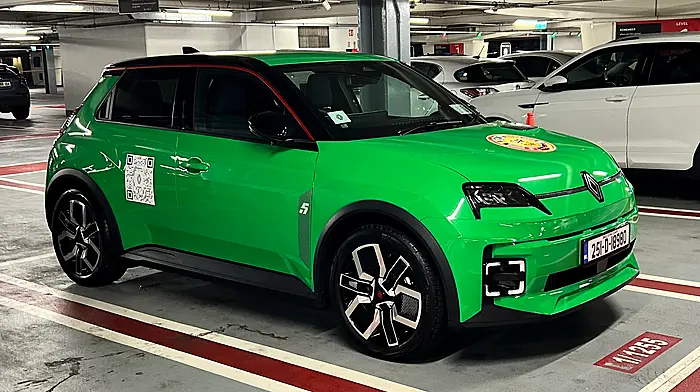BY TRISH WHELAN
OPEL recently introduced its new Grandland SUV flagship to the key C-SUV segment in Ireland. This mid-sized family crossover-SUV is the biggest in the brand’s line-up, offering more inside space than its siblings Mokka or Crossland. Designed and produced in Germany, it is elegantly sporty and shows the new signature Opel Vizor brand face or ‘nose’ that we first saw in the Mokka and now repeated in the newly-launched Astra hatchback. It looks visually appealing and adds its own distinctive style to the car.
This is a spacious, comfortable and practical family five-seater. I was also able to get a good driving position helped by the driver seat adjustments and with the steering column adjustable for both reach and rake. The seats are really comfortable and supportive. The driver’s has multi-way adjustments and lumbar support. However, three adults may find it a bit of a squeeze in the rear as the centre seat is smaller than the outer two and there’s not huge legroom. Head space, though, is excellent. It was also quite dark in the rear with the high side windows and privacy glass.
The dash gets the brand’s Pure Panel cockpit set-up and technology and comfort features. The look is stylish yet simple and is dominated by two big screens. The lower grade model is equipped with a 7-inch touchscreen and 7-inch digital driver information display while the higher specs add a 10-inch infotainment colour touchscreen with navigation and Apple CarPlay/Android Auto, as well as a 12-inch digital multi-colour driver instrumentation cluster which is easy to see and read at a glance with current speed displayed in big digital figures.
At the car’s launch, James Brooks, Opel Ireland MD, said the brand realised the importance of traditional-type controls for climate control so you don’t have to go through the infotainment screen to get at them. In this case, my car came with dual zone air conditioning. There’s a USB port in the front as well as a wireless charger and another USB port in the back.



The boot is of a very decent 514 litres - not the biggest in its class but will take a buggy or some large suitcases. There was a well for a spare tyre provided below the floor.
A big list of standard safety and comfort equipment will attract both existing and conquest customers alike. Three trims are SC, SRI and Elite. The entry has, as standard, active emergency braking, cruise control with speed limiter, side blind spot alert, enhanced traffic sign recognition, hill start assist with an electronic parking brake, dual zone air conditioning, DAB radio, Apple CarPlay and Android Auto, Bluetooth, 17-inch alloy wheels, auto headlamps/wipers, front fogs, front and rear parking sensors and rear view camera.
My car was in the sporty SRI grade which adds half leather-effect seat trim, the larger touchscreen with satellite navigation and bigger driver information cluster, 18-inch alloys and privacy tinted windows. The Elite gets keyless entry and start, heated front/rear seats/steering wheel, electrically adjustable front seats, leather upholstery, 19-inch alloy wheels and a handsfree electric tailgate and the blind spot alert system.
Customers have a choice between a turbo petrol 1.2 outputting 130hp matched with a 6-speed manual (139g/km C02) or a similar 8-speed automatic gearbox (145g/km C02). The diesel is a 1.5 130hp with 130hp and 8-speed automatic transmission with the same road tax. There’s no manual.
On the narrow, twisty roads around the launch hotel, I felt the engine was just a tad tepid pulling such a large car. However, that notion was soon dispelled when I had a proper week-long test drive in the petrol 1.2, taking in primary roads and motorways and could enjoy the car at increased speeds. The car proved quiet enough on the road, but some road noise necessitated turning up the radio volume.
A plug-in electric hybrid outputting 225hp 2WD version will arrive later this year with a 300hp AWD version to follow.










